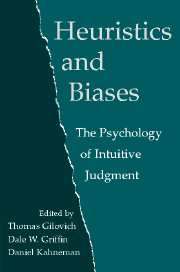Book contents
- Frontmatter
- Contents
- List of Contributors
- Preface
- Introduction – Heuristics and Biases: Then and Now
- PART ONE THEORETICAL AND EMPIRICAL EXTENSIONS
- PART TWO NEW THEORETICAL DIRECTIONS
- PART THREE REAL-WORLD APPLICATIONS
- 33 The Hot Hand in Basketball: On the Misperception of Random Sequences
- 34 Like Goes with Like: The Role of Representativeness in Erroneous and Pseudo-Scientific Beliefs
- 35 When Less Is More: Counterfactual Thinking and Satisfaction among Olympic Medalists
- 36 Understanding Misunderstanding: Social Psychological Perspectives
- 37 Assessing Uncertainty in Physical Constants
- 38 Do Analysts Overreact?
- 39 The Calibration of Expert Judgment: Heuristics and Biases Beyond the Laboratory
- 40 Clinical versus Actuarial Judgment
- 41 Heuristics and Biases in Application
- 42 Theory-Driven Reasoning about Plausible Pasts and Probable Futures in World Politics
- References
- Index
34 - Like Goes with Like: The Role of Representativeness in Erroneous and Pseudo-Scientific Beliefs
from PART THREE - REAL-WORLD APPLICATIONS
Published online by Cambridge University Press: 05 June 2012
- Frontmatter
- Contents
- List of Contributors
- Preface
- Introduction – Heuristics and Biases: Then and Now
- PART ONE THEORETICAL AND EMPIRICAL EXTENSIONS
- PART TWO NEW THEORETICAL DIRECTIONS
- PART THREE REAL-WORLD APPLICATIONS
- 33 The Hot Hand in Basketball: On the Misperception of Random Sequences
- 34 Like Goes with Like: The Role of Representativeness in Erroneous and Pseudo-Scientific Beliefs
- 35 When Less Is More: Counterfactual Thinking and Satisfaction among Olympic Medalists
- 36 Understanding Misunderstanding: Social Psychological Perspectives
- 37 Assessing Uncertainty in Physical Constants
- 38 Do Analysts Overreact?
- 39 The Calibration of Expert Judgment: Heuristics and Biases Beyond the Laboratory
- 40 Clinical versus Actuarial Judgment
- 41 Heuristics and Biases in Application
- 42 Theory-Driven Reasoning about Plausible Pasts and Probable Futures in World Politics
- References
- Index
Summary
As its name implies, the heuristics and biases approach to human judgment has both positive and negative agendas (Griffin, Gonzalez, & Varey, 2001). The positive agenda is to identify the mental operations that yield rapid and compelling solutions to a host of everyday judgmental problems. Most notably, Kahneman and Tversky identified a small number of automatic assessments – similarity, generation of examples, causal judgments – that are made rapidly in response to particular problems and thus exert considerable influence on the judgments that are ultimately rendered (Kahneman & Tversky, 1972; Tversky & Kahneman, 1974). When ascertaining the likelihood that someone is an engineer, for example, one cannot help but assess the similarity between the person in question and the prototypical engineer, and the resultant assessment is, at the very least, the starting point for the judgment of likelihood. Thus, the positive agenda is to understand what the processes of judgment are like.
The negative agenda is to understand what the processes of judgment are not like. Because assessments of similarity, the generation of examples, and causal judgments obey their own logic, everyday judgment will not always be fully “rational” and will not always conform to the laws of probability. Thus, Kahneman and Tversky demonstrated that people's judgments are insufficiently sensitive to sample size, regression effects, prior odds, or, more generally, the reliability and diagnosticity of evidence. Their experiments were carefully crafted to reveal discrepancies between intuitive judgment and what is called for by the appropriate normative analysis.
Information
- Type
- Chapter
- Information
- Heuristics and BiasesThe Psychology of Intuitive Judgment, pp. 617 - 624Publisher: Cambridge University PressPrint publication year: 2002
Accessibility standard: Unknown
Why this information is here
This section outlines the accessibility features of this content - including support for screen readers, full keyboard navigation and high-contrast display options. This may not be relevant for you.Accessibility Information
- 21
- Cited by
